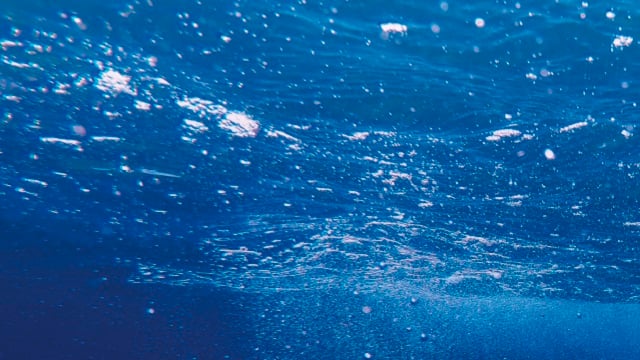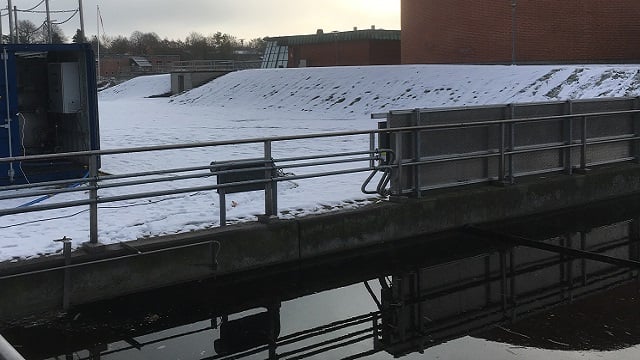How to clean microplastics from the ocean
Studies show microplastics have devastating impact on the marine environment. In a Danish research project, Alfa Laval’s membranes proved to effectively remove this invisible menace from wastewater.
DATE 2023-11-28 AUTHOR Richard Orange
There might be as many as 50 trillion particles of microplastic in the world's oceans. These plastic fragments of pollution, each smaller than 5mm in diameter, have been found in 16 out of 17 brands of sea salt, four out of five samples of drinking water, and 80 percent of British mussels.
"The problem with microplastics is that they don't disappear in the environment," says Claudia Sick, biologist and project manager at the Danish NGO Plastic Change. "Plastic takes an extremely long time to degrade completely – many hundreds of years or more – and during this long period, these particles of different sizes risk causing harm to a variety of organisms."
Small but vicious
Most of us rarely encounter the larger pieces of plastic pollution that are the most visible components of ocean junkyards such as the Great Pacific Garbage Patch, a spinning concentration of plastic bigger than Texas discovered in 1985. But we all regularly swallow pieces of microplastic. And although the human health effects are unknown, there is mounting evidence they are harming animal life, particularly in the seas.
"These small particles physically block or reduce the functionality of vital organs; in a mussel, microplastic particles can stick to their feeding filtration organs, and in fish, to the gills or inside their digestive systems," says Sick. This can have a devastating impact on marine wildlife. prevent organisms catching or digesting food, inducing stress, and even prevent them from breathing properly.
According to Emmanuel Joncquez, a membrane bioreactor process specialist at Alfa Laval, research into this global issue is only just getting underway, even if the problem is increasingly recognized. The UN Environment Programme this year launched its Clean Seas project, encouraging countries to take measures such as banning the use of microplastics in cosmetics.
"The problem could be even worse than we think, because microplastics are very difficult to find and measure," says Joncquez. Few ocean trawls have tried to pick up particles below 0.3mm in diameter, and between this diameter and 0.005mm there is still no scientifically accepted way of quantifying them. "When you filter down to this size, the standard analysis systems struggle to tell if it's a plastic or another material," says Joncquez.
Where does microplastic come from?
Microplastics are divided between "primary materials" — microplastics used, for example, as exfoliants in care products and cosmetics, or for air-blasting off paint and rust — and "secondary materials". These are fragments created by the disintegration of larger pieces of plastic, such as fibres from textiles, car tyres, and packaging.
Award-winning pilot project
Alfa Laval has worked with Plastic Change, Aarhus University, Roskilde University and EnviDan to measure the quantities of microplastics released into Denmark's Roskilde Fjord from the Bjergmarken wastewater treatment plant. Alfa Laval financed, installed, managed and operated a membrane bioreactor (MBR) pilot plant capable of filtering down to 0.2μm (micrometers) — one thousandth of the diameter of the nets or filters used in standard plastic trawls. The plant helped the research by concentrating the suspended solids in the retained water by 50 times, so that they could be studied.
"The concentration of plastics in Danish wastewater is luckily not so high today, so you need to filter a large volume of water to get an adequate sample," Sick explains. "Alfa Laval's MBR was of great help, since it could create a concentrate of the plastic from a large volume of wastewater.
Read more about this award-winning project
Membrane technology to 'catch' microplastics
"What I found most interesting so far is that about 1% to 5% of the microplastic going through the wastewater treatment plant is ending up in the treated wastewater, and 80% ends up in the sludge."
More than 50% of Danish sludge is used as a fertilizer in agriculture, so the plastic caught in the sludge by the plant is returned to farmland, where it might change the behaviour and health of key earth organisms, before possibly being washed into rivers, fjords and the sea.
For Alfa Laval, the study supports previous studies showing that the MBR process is an efficient way of removing microplastics. No microplastic particles have yet been found in the wastewater treated by the pilot plant, with analysis so far done down to 50μm. "It confirms that MBR retains more microplastics than conventional technologies," Joncquez says.
Membrane bioreactor technology is today still more costly and energy intensive than sedimentation tanks, which limits its use to where there are space constraints, specific output requirements, or where land is expensive. According to Joncquez, Nordic municipalities are starting to think about MBR as a solution to the microplastics problem.
Coming regulations
"People know that there might be a regulation on plastic coming, and they are starting to look for solutions." But Joncquez thinks it will take a few years for scientists to develop an effective, standardized way to measure the amount of microplastics in water.
Governments are already taking action at the supply end, however, with the UK and Sweden promising bans on the sale of cosmetics containing microbeads by the start of 2018, following similar moves in the US, Canada and the Netherlands.
But Joncquez believes there's a long way to go. "Avoiding more plastic going into the sea is really important, and it should happen," he says. "But, as with climate change regulation, it might take 50 years." But with a UN resolution in December 2017 calling on all members to "prioritize policies" that "avoid marine litter and microplastics entering the marine environment", the tide is starting to turn.
あなたの好奇心をアルファ・ラバルで生かしてみませんか?
アルファ・ラバルは、困難な課題を解決するために、常に一歩先を行くことを目指しています。お客様、人々、そして地球のより良い未来のために、成功を加速させることが私たちのミッションであり、それを可能にするのは、何事にも好奇心を持って取り組む仲間です。好奇心は優れたアイデアを生み出す原動力であり、そこから生まれたアイデアは私たちの生活に進歩を促します。
アルファ・ラバルでは、好奇心を持つ人材が、仕事を通じて世界レベルの課題解決に向けてチャレンジする機会を大切にしています。是非採用情報をチェックしてみてください。
より良い進歩のために。アルファ・ラバルと共に。
アルファ・ラバルのグローバルゴールへの貢献
国連は、世界のリーダー達が2030年までに達成するグローバルゴールとして、17の持続可能な開発目標(SDGs)を採択しました。そして今、我々のような企業もまたその達成を目指します。
PRODUCT - MBR membranes
 Benefits:
Benefits:
- Minimize power consumption
- Reduce cleaning needs
- Facilitate maintenance
- Maximize capacity
“It confirms that MBR retains more microplastics than conventional technologies”
EMMANUEL JONCQUEZ membrane bioreactor process specialist at Alfa Laval.

DID YOU KNOW THAT
..a Danish study conducted in Roskilde Fjord found, on average, one plastic particle in every mussel, and one to four particles in each fish?
.. a turtle in Bermuda was found with more than 2,000 pieces of microplastic inside it – and it died. A study from the University of Queensland estimates that more than half the world's sea turtles have ingested plastic.
Microplastics pollution project wins National Energy Globe Award with Alfa Laval’s support
The accolade is awarded annually to environmental projects around the world by the Energy Globe Foundation.

Read Here customer magazine No 36
United Nations Sustainable Development Goals (SDGs) set the vision humanity needs to work towards, now it's up to businesses like ours to take us there. Read how we and our customers make a difference.
